Bent's Fort
Bent's Fort became an important trading center in southern Colorado. The Bents completed the original adobe fort in 1835.
Origins Of Bent's Fort
Lieutenant J. W. Abert made this drawing of Bent's Fort in 1845. However, the Bents had been trading and trapping in the region for years before they built their fort. Charles Bent entered the fur trade in about 1816. He worked for the American Fur Company on the upper Missouri River. This area is in present-day Wyoming and Montana. Several years later, his brother William joined him in that work. In about 1824, the Bent brothers met Ceran St. Vrain, another young trapper. They became friends. The three decided to form the own fur trapping company. Before long, they came to the area that is now Colorado. They built a stockade near where Pueblo is now located.
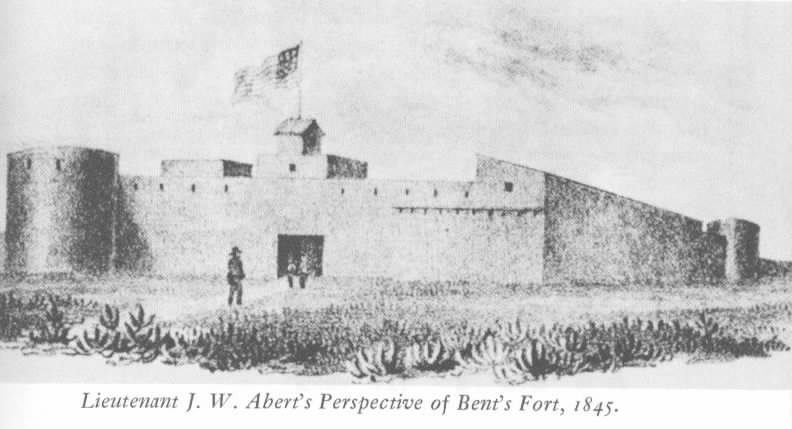
Photo: Lieutenant J. W. Abert's Drawing of Bent's Fort, 1845
More About This Topic
When the Bents and St. Vrain built their first stockade on the Arkansas River, they were interested in trapping beaver. Meanwhile, the Cheyenne and Arapaho Indians began moving into this area. In about 1827, the partners built a new stockade on the Arkansas River, but farther downstream. The new stockade was about 75 miles east of their first one. Here they had more contact with the Indian tribes. The partners began to make friends with these tribes.
Their Own Words
"Fort William, or Bent’s Fort, on the north side of the Arkansas, eighty miles north by east from Taos in the Mexican dominions, and about one hundred and sixty miles from the mountains, was erected by gentlemen owners in 1832, for purposes of trade with the Spaniards of Santa Fe and Taos, and the Eutaw, Cheyenne and Cumanche Indians."
Source: Thomas Jefferson Farnham. (1843) Quoted in James H. Maquire, Peter Wild and Donald Barclay. Ed. A Rendezvous Reader. Salt Lake City: University of Utah Press, 1997: 72.
Building Bent's Fort
In about 1829, the Bents began to replace their stockade with the adobe fort you see in the photo. Charles Bent has been involved in the Santa Fe trade for several years. Having spent time in Santa Fe and Taos, Charles knew the virtues of building with adobe bricks. Adobe dwellings were cool in summer and warm in winter. They were also fireproof. And in an area short of timber, adobe was a good material with which to build.
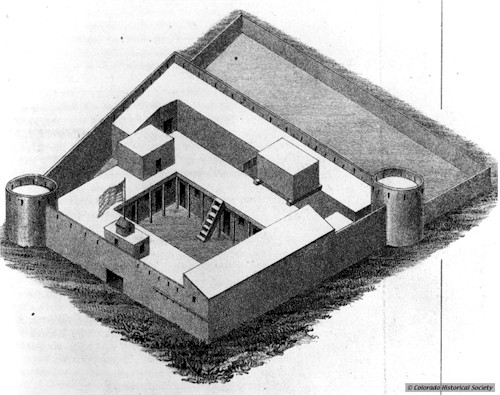
Photo: Colorado Historical Society
More About This Topic
To build the fort, the Bents hired Mexicans who were expert in building with adobe brick. No sooner had the Mexicans arrived from Santa Fe than a smallpox epidemic broke out among them. So many of these workers died from the disease that a new labor force had to be recruited in New Mexico. This episode delayed building the fort. William Bent, Ceran St. Vrain, and the famous scout Kit Carson also caught the disease. Indians who might have visited the Bent stockade were warned off in time to avoid the smallpox.
Their Own Words
"It is in the form of a parallelogram, the northern and southern sides of which are about a hundred and fifty feet, and the eastern and western a hundred feet in length. The walls are six or seven feet in thickness at the base, and seventeen or eighteen feet in height. The fort is entered through a large gateway on the eastern side, in which swing a pair of immense plank doors. At the north-west and south-east corners stand two cylindrical bastions, about ten feet in diameter and thirty feet in height."
Source: Thomas Jefferson Farnham. (1843) Quoted in James H. Maquire, Peter Wild and Donald Barclay. Ed. A Rendezvous Reader. Salt Lake City: University of Utah Press, 1997: 72.
Diagram Of Bent's Fort
The diagram shows that Bent's Fort was built for defensive purposes. Although the Bents were on friendly terms with most of the Indian tribes in the region, they could take no chances. In fact, many of the Indian tribes in the region were often at war with one another, and sometimes the Bents were caught in the middle. When Matthew Field visited Bent's Fort in 1840, he said that "although built of the simple prairie soil, made to hold together by a rude mixture with straw and the plain grass itself . . . [the fort] is constructed with all the defensive capacities of a complete fortification."
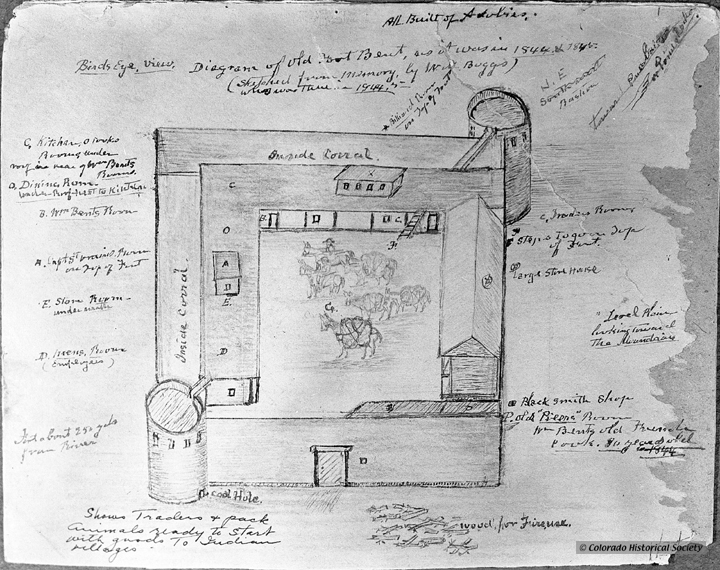
Photo: Colorado Historical Society
More About This Topic
Matthew Field noted that "the dwellings, the kitchens, the arrangements for comfort are all such as to strike the wanderer with the liveliest surprise, as though an 'air-built castle' had dropped to earth before him in the midst of the vast desert." The diagram shows that the fort contained within its walls everything necessary to the Bent's business. It had several store rooms, a trade room, a carpenter shop, a blacksmith shop, and several kitchens. In addition, most of the people in the Bent's employ lived within the confines of the fort.
Their Own Words
"[Bent's Fort] is in the form of a parallelogram, the northern and southern sides of which are about a hundred and fifty feet, and the eastern and western a hundred feet in length. The walls are six or seven feet in thickness at the base, and seventeen or eighteen feet in height. The fort is entered through a large gateway on the eastern side, in which swing a pair of immense plank doors. At the north-west and south-east corners stand two cylindrical bastions, about ten feet in diameter and thirty feet in height."
Source: Thomas Jefferson Farnham (1843) Quoted in James H. Maguire, Peter Wild, and Donald A Barclay. Ed. A Rendezvous Reader. Salt Lake City, UT: University of Utah Press, 1997: 72.
The Bent's Indian Trade
The map shows most of the Indian tribes with whom the Bents traded. Local Indians were only one part of the Bent's three-cornered trade network. One corner was Missouri, where the Bents bought manufactured goods. A second corner was New Mexico, where they got such goods as mules, horses, blankets, and silver. A third corner was the Bent's trade with the Indians. This trade was based on exchanging Indians' buffalo robes and meat and horses for manufactured goods of various kinds. The Bents worked hard at maintaining good relations with Indian tribes. The Indian trade was a very important part of their business.
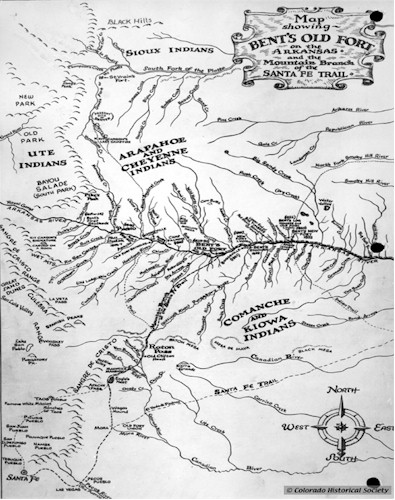
Photo: Colorado Historical Society
More About This Topic
The Bents traded with most of the Indian tribes in the region. These tribes included Cheyenne, Arapaho, Ute, Kiowa, Comanche, and Northern Apache. The Indians often came to the fort to trade their robes and horses for guns, powder, knives, blankets, tools, and other manufactured goods. Almost as often, traders from the fort went out to the Indians' camps to trade. Sometimes these trading relations were upset when one Indian tribe went to war with another one. The Bents and their traders had to be very careful. They tried to remain neutral when these hostilities broke out.
Their Own Words
"Bent's Old Fort was completed in 1832, and from that time my father lived there and was in command of the post most of the time. About 1835 he married my mother Owl Woman . . . and thus became a member of the Cheyenne tribe. Part of the Cheyenne and Arapahos moved down from the Platte [River] to live near the Arkansas [River], and there bands wintered each year at the Big Timbers, thirty-five miles below the fort. They often camped for long periods right around the fort, coming in every day to trade."
Source: George Hyde. Life of George Bent: Written from His Letters. Savoie Lottinville. Ed. Norman: University of Oklahoma Press, 1968: 68.
The Bent's Missouri Trade
The photo to the right shows a wagon train traveling over the plains. Every spring the Bent & St. Vrain Company sent a wagon train down the Santa Fe Trail. They usually ended their journey at a place called Westport (now Kansas City, Missouri). The wagons carried furs, buffalo robes, and silver. The wagon train also took herds of horses, mules, and cattle. The company had traded for these things during the fall and winter. On their return trip, the wagons carried manufactured goods that the company would use to trade for furs, robes, and the other items.
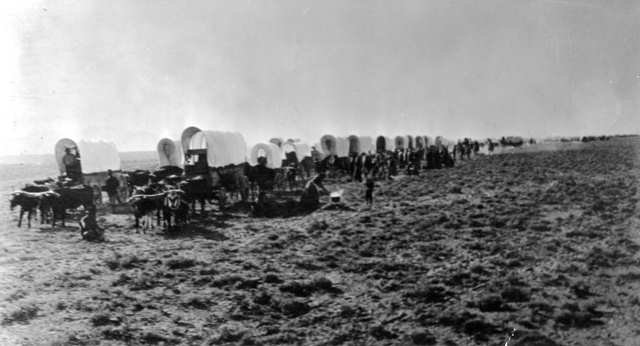
Photo: Denver Public Library, Western History Collection
More About This Topic
It was 530 miles from Bent's Fort to Westport, Missouri. Between the two places there was no settlement, trading post, or even government fort. Usually six yokes of oxen pulled the big wagons. Often the train consisted of 25 to 30 wagons. At night the wagons were put in a tight circle. The oxen were turned loose inside the corral to eat grass. In the mornings, the train usually started before breakfast. Then at 10:00 o'clock, the train stopped and the traders cooked breakfast. At about 2:00 o'clock, the train started again and usually did not stop until dark.
Their Own Words
"The distance [the wagon train] made each day was not fixed, sometimes a long move was made, and again only a short one. The wagon boss knew all of the best camping places along the five hundred miles of trail, and he regulated the train's movements so as to reach a good camping place with good wood, water, and grass each evening. A hunter was always taken along to provide the outfit with fresh meat, and as the greater part of the march was right through the heart of the buffalo range, meat was usually supplied in abundance."
Source: George Hyde. Life of George Bent: Written from His Letters. Savoie Lottinville. Ed. Norman: University of Oklahoma Press, 1968: 70-71.
The Bent's Mexican Trade
This drawing shows a wagon train entering Santa Fe in the late 1830s. One of the Bent brothers, Charles, made his first trading journey to Santa Fe in 1829. He made several trips over the Santa Fe Trail in the next few years. Bent was sharp at business and he saw great opportunities in the Mexican trade. In fact, it was the Santa Fe trade that originally led Charles and Ceran St. Vrain to become partners. St. Vrain eventually became a Mexican citizen to help with the partnership's trading there.
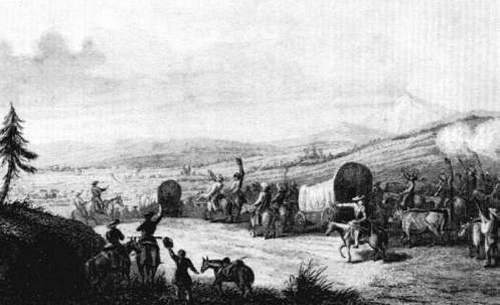
Photo: Josiah Gregg, Commerce of the Prairies, 1844
More About This Topic
As Charles Bent and Ceran St. Vrain were getting established in business in [New] Mexico, William had begun to trade with Indians on the plains north of the Arkansas River. It was Charles, however, who imagined how this trade on the plains might be expanded. It was Charles who imagined the need for a sturdy fort to begin trading in earnest on the plains. And it was Charles who, after living in Mexico, had the idea to build their trading post of adobe brick. Finally, it was Charles who saw how the Indian, Mexican, and Missouri trade might mesh together.
Their Own Words
"Besides trading with the Indians, my father used to send some of his best traders down to New Mexico--to Santa Fe and Taos--with wagonloads of goods from the fort. They brought back from New Mexico horses, mules, cattle, Mexican blankets, silver dollars, and silver bullion in bars. I remember when a boy seeing the wagons come in with their loads of bright colored blankets. The Indians prized these blankets with their stripes of bright coloring very highly, and a good blanket was traded at the fort for ten buffalo robes. The silver, horses, mules, and cattle, were taken to Missouri and sold."
Source: George Hyde. Life of George Bent: Written from His Letters. Savoie Lottinville. Ed. Norman: University of Oklahoma Press, 1968: 69.
The Bent's Adobe Empire
The drawing depicts a wagon train of white settlers crossing the Platte River. Although Bent's Fort became the center of the company's activities, the partners began trading with the wagon trains heading for Oregon. They also opened a new trading post near where the St. Vrain River enters into the Platte River. This post was to trade with the Sioux, the Northern Cheyenne, and Northern Arapaho. They also opened a fort in what is now New Mexico. This trading post was on the Canadian River. Here they traded with such southern Indian tribes as the Kiowa and Comanche.
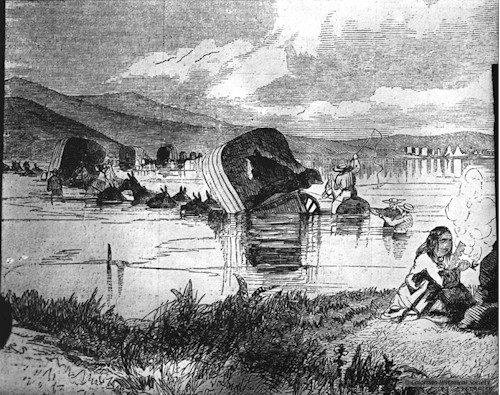
Photo: Colorado Historical Society
More About This Topic
Sometimes the Bent, St. Vrain & Company's business grew in unexpected ways. For example, when the partners opened Bent's Fort, there was little American migration across the plains. By the late 1840s, however, large numbers of emigrants (white settlers) were beginning to travel west. The Platte River Valley became their major route west. This route became known as the Oregon Trail. Bent traders took goods, especially horses and mules, north from the fort to trade with these travelers.
Their Own Words
"Other tribes also came to the fort to trade, but as the Cheyennes were at war with the Kiowas, Comanches, and Prairie Apaches, these three tribes could not come to the fort and traders had to be sent to the different camps. In later years two branch forts were established by the Bent and St. Vrain Company: Ft. St. Vrain on the Platte [River], opposite the mouth of St. Vrain's [River], for the Sioux, Cheyenne, and Arapaho trade, and Adobe Fort on the Canadian [River, in New Mexico] for the Kiowa, Comanche, and Apache trade. These two forts, like Bent's Fort, were built of adobe."
Source: George Hyde. Life of George Bent: Written from His Letters. Savoie Lottinville. Ed. Norman: University of Oklahoma Press, 1968: 68.
End Of The Bent's Trading Empire
The photo to the right shows the ruins of Bent's Old Fort. According to Savoie Lottinville, William Bent blew up the fort in August 1849. One reason for blowing up the fort, according to Lottinville, was that a cholera epidemic brought disaster to the Indians who often traded at the post. There were other reasons as well. The recently ended Mexican War changed everything for people living on the plains. Now there were many more army troops on the plains and the Indians avoided them when possible. By this time, too, the fur trade was dead.
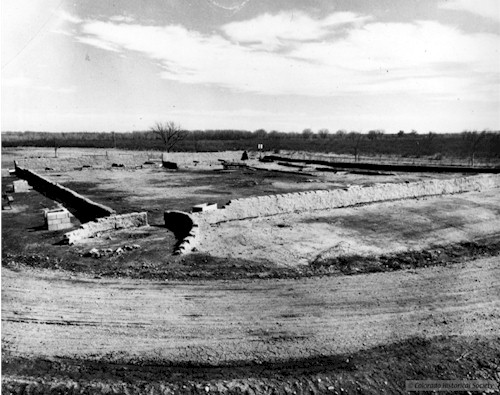
Photo: Colorado Historical Society
More About This Topic
After the Mexican War (which ended in 1848), the War Department offered to buy Bent's Fort. William Bent seemed willing to sell it. However, the government offered only $12,000, which William did not think a fair price. The Bents abandoned the fort and William blew it up. The old fort was not completely destroyed as you can see in the photo to the right. In time, people realized the significance of the fort and efforts were made to reconstruct the fort.
Their Own Words
"After the Mexican War the fur business had fallen off to such an extent that it was no longer profitable to maintain large trading posts, so when the War Department offered to buy Bent's Fort and turn it into a military post, may father said that he was willing to sell. The government, however, offered him only $12,000, and . . . he refused to sell, abandoned the fort and blew it into the air."
Source: George Hyde. Life of George Bent: Written from His Letters. Savoie Lottinville. Ed. Norman: University of Oklahoma Press, 1968: 93.

